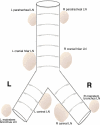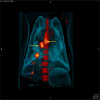Immunology studies in non-human primate models of tuberculosis
- PMID: 25703552
- PMCID: PMC4339213
- DOI: 10.1111/imr.12258
Immunology studies in non-human primate models of tuberculosis
Abstract
Non-human primates, primarily macaques, have been used to study tuberculosis for decades. However, in the last 15 years, this model has been refined substantially to allow careful investigations of the immune response and host-pathogen interactions in Mycobacterium tuberculosis infection. Low-dose challenge with fully virulent strains in cynomolgus macaques result in the full clinical spectrum seen in humans, including latent and active infection. Reagents from humans are usually cross-reactive with macaques, further facilitating the use of this model system to study tuberculosis. Finally, macaques develop the spectrum of granuloma types seen in humans, providing a unique opportunity to investigate bacterial and host factors at the local (lung and lymph node) level. Here, we review the past decade of immunology and pathology studies in macaque models of tuberculosis.
Keywords: granuloma; immunology; lymph node; macaque; non-human primate; tuberculosis.
© 2015 John Wiley & Sons A/S. Published by John Wiley & Sons Ltd.
Figures




Comment in
-
Primate models of tuberculosis. Faith-based or evidence-based science.Tuberculosis (Edinb). 2016 Dec;101:54-55. doi: 10.1016/j.tube.2016.08.003. Epub 2016 Aug 26. Tuberculosis (Edinb). 2016. PMID: 27865398 No abstract available.
References
-
- Gupta UD, Katoch VM. Animal models of tuberculosis. Tuberculosis (Edinb) 2005;85:277–293. - PubMed
Publication types
MeSH terms
Substances
Grants and funding
- AI063101/AI/NIAID NIH HHS/United States
- K08 AI063101/AI/NIAID NIH HHS/United States
- R01 AI050732/AI/NIAID NIH HHS/United States
- R01 AI094745/AI/NIAID NIH HHS/United States
- AI094745/AI/NIAID NIH HHS/United States
- AI50732/AI/NIAID NIH HHS/United States
- HL106804/HL/NHLBI NIH HHS/United States
- R01 HL106804/HL/NHLBI NIH HHS/United States
- R01 EB012579/EB/NIBIB NIH HHS/United States
- EB012579/EB/NIBIB NIH HHS/United States
- AI105422/AI/NIAID NIH HHS/United States
- HL110811/HL/NHLBI NIH HHS/United States
- R01 HL110811/HL/NHLBI NIH HHS/United States
- R01 AI105422/AI/NIAID NIH HHS/United States
LinkOut - more resources
Full Text Sources
Other Literature Sources
Medical
Miscellaneous

